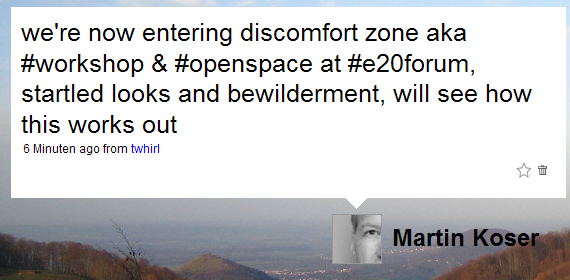Reporting the talk by Prof. Dr. Michael Koch, Universität der Bundeswehr München of the results of the SNS-Study (“Ergebnisse einer Best-Practice-Studie: Erfolgfaktoren bei Kooperationssystemen 2.0“) is hard. So I rather forward you to his blog, site and all. Anyway, for some instant information you can check out my writeup of the pre-conference interview (“Enterprise 2.0 implications and digital natives“).
Now it’s up to the most interesting part of the afternoon, see my (racy but tongue in cheek) tweet down below. But I guess this is really one thing conferences need to integrate to stay relevant (see the Sweettt podcast epsiode “Conversations as The Future of Conferences” for more on this):
Well, I’m in the track that’s collecting thoughts and ideas on management involvement in Enterprise 2.0 (well, how to convince your CxO). I am feeling a bit awkward as I don’t want to spoil the emerging ideas of the group with my views …
Well, anyway – some collected thoughts by the group, alas, these are only quick and brief notes:
Quick wins (or how to win management sponsorship quickly): We’fre not alone, there are cases, people in the know, consultants (hint …), it’s about time to act now and one of the best: arguing with usages for existing and pressing problems
Challenges (or what gets into the ways of our ambitions with Enterprise 2.0): fear in all flavours, seen (and dreaded) need to change management’s understanding and role – we don’t want to change and we fear democracy and transparency
Supporting lines (or the surefire ways to convince your CEO): Return on Investment (both in terms of more turnover and/or reduced costs), CxOs must act as role models, innovation and knowledge management benefits, competitive advantages, leveraging the distributed potentials of all our employees, …
The other groups tackled issues like e.g.
- technology – no need to talk about this, all things Open-Source vs. Closed-Source et al.
- implementation (well, rather early stages of getting Enterprise 2.0 out there)
- motivation – or how to get employees to use these systems?
- integration – how can be fit it into existing infrastructure (of any kind)
- role of IT
- role of moderation in Enterprise 2.0 (well, turned out that they dealt with nifty details of organizational culture in the context of E 2.0 at last, plus a collection of sensible roles and personas to have in E 2.0 projects)

